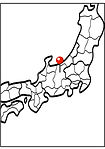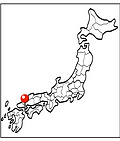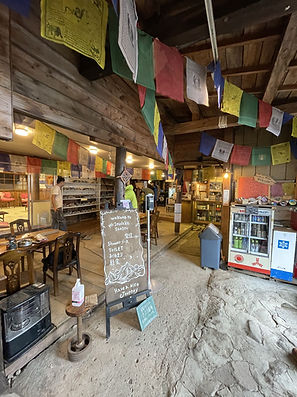From the rugged peaks of the Northern Alps to the lush forests of Yakushima, Japan offers a diverse range of hiking experiences for hikers of all levels.
When people talk about mountains and Japan, Mt. Fuji is usually the first peak that comes to mind. And while Mount Fuji is certainly Japan's most iconic peak, its popularity results in overcrowded trails and the views as a standalone peak are actually not worth your while.
In this post, we will introduce stunning hikes for all levels that are much more scenic, interesting, and worth your time when hiking in Japan. Keep reading to learn more about how to plan your hike, mountain huts, and what to keep in mind when hiking in Japan.
Hiking Season
Mid/End July to early October
This is the peak hiking season for alpine and higher elevation peaks. During this period the huts will be open and there is no snow on the trail. It’s recommended to start your hikes early to avoid the heat during the day and arrive at the huts before thunderstorms in the afternoon.
April to July (early July)
From April to mid June it’s still winter in the alps with lots of snow. Snowstorms and avalanches are possible and crampons and ice axe are needed. From mid June to mid July it's rainy season. During rainy season many areas experience bad weather and landslides, unpassable rivers and closed trails are common.
Mid October to mid November
For alpine peaks it’s shoulder season again with the first snow usually around mid October. Temperatures drop to zero or lower at night and days are shorter. For lower peaks this time has beautiful fall colors and pleasant temperatures.
Mid November to April
Winter in Japan will have snow on most peaks. In the alps expect full winter mountaineering conditions. Check the “Snowfree Hikes” and “Winter Hikes” articles if you want to go hiking during this time.

Trail Access
Japan is famous for its public transportation and that also includes the majority of popular hikes. Many trailheads are on private roads which only allow access by bus and taxi. Usually that means that they are only accessible during the main hiking season and not in winter. (Kamikochi, Murodo, Hirogawara) Make sure to check if busses are running and include the access time into your planning. Many require an overnight stay in the area the night before.
Mountain Huts
The mountain hut infrastructure in Japan is amazing and makes multiday and overnight hikes very convenient and accessible. They are also a great way to socialize with Japanese hikers and experience more of Japans unique hiking culture. Compared to European or North American huts, they are more hospitable but they also have more rules and are notoriously hard to reserve from abroad. Make sure to check the websites thoroughly and reserve your stay. If you need help reserving them check here, or read more in the full article.
Hiking Insurance
Before you set off on your hikes get rescue insurance! If you get injured, rescue in Japan is not free and can get expensive quickly. For the best Japanese and International providers check here.
Hiking Itinerary
If you are feeling overwhelmed by choice and don't know where to start or plan your trip we can help. With years of experience exploring Japan's mountains, both my Japanese partner and I are well-equipped to design custom itineraries tailored to your needs. Check here for more info.

Hiking in Japan
Hike: Hakubayari Traverse

Northern Alps
The Daikiretto is the second half of the Hida ridge, continuing from Okuhodaka to Minamidake. It's an incredibly beautiful but also very exposed/technical multiday hike. You'll need upper body strength and also climbing skills for the chains, bolts and ladders. Proceed with caution, this hike is more climbing then walking and don't forget to bring gloves and a helmet.
Level: 5/5 Strenuous: 4/5 Technical 5/5
Harinokidake 2821m is an intermediate dayhike with beautiful views of the Kurobe Dam and the Hotaka mountains. There is a snow valley for most of the year, so depending on the month you might need crampons. This hike is a great choice if you want to get away from the masses at Tateyama and still enjoy an alpine peak with scenic views. It's also easy to access by public transportation.
Level: 3/5 Strenous: 3/5 Technical: 2/5
Omote Ginza is a scenic 3-4 day ridgeline traverse from Tsubakuro to Yarigatake, ending in Kamikochi. It's a very popular route with beautiful views and intermediate difficulty. The best time for this hike is once the snow melts from July to mid October. In summer this route can get busy, so start early and make your reservations early!
Level: 3/5 Strenous: 3/5 Technical: 2/5
Okuhotaka 3190m is a beautiful and difficult overnight hike from Kamikochi. It's the third highest peak in Japan after Mt. Fuji and Kitadake. The route described here passes by Maehodaka and is very strenuous. It also requires a helmet because of the loose rock and rockfall. If you climb the detour to Maehodaka you'll also need scramble skills.
Level: 4/5 Strenuous: 4/5 Technical: 4/5
The traverse from Hakubayari Onsen to Karamatsu is an overnight hike with amazing scenery and a challenging ridge line. You pass by an outdoor hot spring and beautiful alpine flowers, traverse an exposed ridgeline with chains. ladders and bolts. And finally on the way down you'll see the scenic happo pond and have the big peaks as a backdrop. This hike can easily be extended and turned into a 3-4 day traverse.
Level 4/5 Strenuous: 3/5 Technical: 4/5
The Shimonoroka in the Kurobe Valley is the most complicated and dangerous, but also most rewarding hike on this list. It's very exposed with dramatic and incredibly scenic views of the Kurobe river. The valley can only be walked for a very short period from September to October because of snow and missing bridges/ladders.
Some years, it might not open at all. Before embarking on this hike, make sure the valley is passable.
Level: 5/5 Strenuous: 4/5 Technical: 5/5

Southern Alps
The traverse from Kitadake to Ainodake to Notoridake, often also called Shirane Sanzan, is a beautiful hike that can be completed in 2-3 days. You'll climb two of the famous hyakumeizan (inclduing Kitadake, Japans second tallest peak) and the ridgeline is very scenic and even has views of Mt.Fuji. The hike is not technical and therefore a good option if you want to explore the alps without dangerous exposure or chains.
Level: 3/5 Strenous: 3/5 Technical: 2/5
Kaikomagatake 2967m with it's famous "swords" is a beautiful and challenging hike in the Southern Alps. This post describes the trail from Ojiragawa Canyon with the Kuroto ridge. The route is very steep and one of Japan's steepest ridgelines (top 3). The hut is open year-round and camping is possible as well.
Level: 4/5 Strenous: 4/5 Technical: 4/5
Houozan and it's 3 peaks, Jizo, Kannon and Yakusi, are a strenuous dayhike or easygoing overnight hike. On the way to the iconic Jizodake you'll pass some beautiful waterfalls and the whole hike is very scenic. It’s not technical, just a bit long and steep. The trailhead is also accessible by bus.
Level: 3/5 Strenous: 3/5 Technical: 2/5
Settogatake is an easy dayhike with amazing views of Fuji. This little hike is perfect if you're in the Fuji 5 lakes area and want to get away from the masses at Kawaguchiko. The trailhead has bus access and the peak has trails connecting it to the ridgeline to make it longer if you have more time and energy.
Level: 2/5 Strenous: 2/5 Technical: 0/5
The loop from Hijiridake to Kamikochidake to Chausudake is a strenuous overnight or easier multiday hike in the Southern Alps. It has lots of elevation gain but it's not technical. This hike is perfect if you’re looking for stunning scenery and less crowds. Access to the trailhead is only possible by car.
Level: 3/5 Strenous: 4/5 Technical: 2/5
Nishizawa Gorge is an intermediate dayhike easily accessible from Kofu or Kawaguchiko. The gorge is famous for its many waterfalls, blue water and beautiful fall colors. Some sections are a bit exposed and might be slippery if you walk it as a loop. The waterfalls can also be accessed by a flat forest trail that is much easier than the loop trail.
Level: 2/5 Strenous: 2/5 Technical: 2/5

Central Japan
Kisokomagatake 2956m is an easy summer hike with alpine feel and views. The ropeway makes it much easier for both winter and summer because you can skip a lot of elevation. This is a good hike if you want to get high up and have nice views, but don't want to climb through the forest for hours. There are also many huts and even a hotel for overnight stays. For a more difficult hike you can include Mt.Houken or traverse to Mt. Utsugi.
Level: 2/5 Strenous: 2/5 Technical: 2/5
Ontakesan 3067 is an active and famous volcano and a beautiful hike at the border of Gifu and Nagano. On a clear day you can often see it from Nagoya. There are two main access routes; Nigorio Onsen and from the ropeway. The peak plateau is large and has many huts, perfect for an overnight stay to wach the stars.
Level: 3/5 Strenous: 3/5 Technical: 2/5
Tengudake 2640m and Honzawa Onsen is an amazing hike famous for having Japan's highest outdoor onsen. The weather is often bad in the Yatsugatake mountains, but if you get lucky you'll have great views and a hot bath to soak with views after. Also the hut is open year-round and the extensive trail network in the Yatsugatake range makes this hike a good starting point for a longer hike as well.
Level: 2/5 Strenous: 2/5 Technical: 2/5
Gozaishodake 1212m is not a very high mountain but the terrain resembles the alps and the views from the top are beautiful. There are many trails to the top with varying difficulty, which makes the mountain interesting for beginner and intermediate hikers. You can also use the ropeway and there is a beautiful waterfall close to the trailhead. It’s easily accessible by direct bus from Nagoya station.
Level: 2/5 Strenous: 2/5 Technical: 2/5
Osugidani valley is an advanced in-and-out dayhike in Mie. It's one of Japans top 3 most beautiful valleys and accessible from spring to fall. The valley receives a lot of rainfall and it's notoriously hard to get a good weather day. Spring and fall usually have the best weather and no or less mountain leeches. The hike is always a bit wet and slippery and it's very exposed with most parts secured by chains.
Level: 3/5 Strenous: 2/5 Technical: 4/5
The Kumano Kodo Nakahechi route is a popular pilgrimage hike in Wakayama. Due to the popularity of the hike and the limited accomodation along the trail, its often booked out months in advance.
However, there are a couple of official campgrounds along the route and it is possible to walk the trail and camp.
Level: 2/5 Strenous: 3/5 Technical: 1/5

Southern Japan
Ishizuchi 1982m is an easy to difficult dayhike depending on if you climb up the chains or use the detours. It's also one of Japans sacred shugendo mountains and closed to woman on July 1st.
Its famous for its 4 sections with almost vertical chains and fall colors. There is also a ropeway that runs year-round.
Level: 3/5 Strenous: 2/5 Technical: 4/5
Tachudake 1497m is a beautiful hike on Yakushima Island. The trail starts from Yakusugiland and is a nice mix of challenge with some chains, beautiful views and ancient trees. It's also far less busy than some of the other hikes on Yakushima and you'll barely see anybody after Yakusugiland and on your way to the granite monolith.
Level: 2/5 Strenous: 2/5 Technical: 2/5
Nakadake 1791m and the Kujurenzan mountain range make for an easy dayhike from Beppu or Yufuin. The whole plateau has many trails and small peaks and it can even be turned into an overnight hike with a stay at Hokkein Onsen Sanso (open year-round).
Level: 2/5 Strenous: 2/5 Technical: 1/5

Northen Japan
The Asahidake 2291m to Nakadake Onsen Loop is an intermediate loop hike in the Daisetsuzan National Park. This hike is a great option if your looking for something a bit longer and challenging than just going to the peak of Asahidake. On the way around you'll also pass by Nakadake Onsen and you can soak your feet in a wild hot spring. The hike has a variety of terrain from alpine ponds to geothermal volcanic areas.
Level: 2/5 Strenous: 2/5 Technical: 2/5
Meakandake 1499m is an easy dayhike reachable from Lake Akan. The color of the rocks is amazing and you can look directly into the crater. Meakan is an active volcano, so check beforehand if there are any restrictions in place.
Level: 2/5 Strenous: 2/5 Technical: 2/5
Still looking for your hike? We offer customized hiking itineraries catered to your skill level and preferences.
Check here for more information.
























